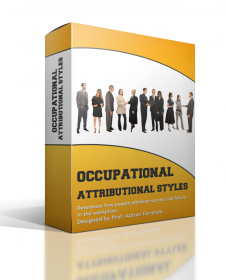Developed from an article in
Human Relations, Vol. 47, 12, 1994
By permission of the first author
THE OCCUPATIONAL ATTRIBUTIONAL STYLES QUESTIONNAIRE AND ATTITUDES TO WORK
Adrian Furnham, Chris R. Brewin and Harriet O'Kelly
SUMMARY
This study examined the relationship between work-specific cognitive style, and measures of organisational commitment, job satisfaction, and involvement. One hundred working adults completed the revised Occupational Attributional Style Questionnaire and three validated measures of work attitudes. In general, cognitive style showed few associations with demographic variables, occupational status, and salary. Internality and perception of personal control over positive outcomes were positively correlated with job commitment, involvement, and satisfaction, a finding that appears to generalize across different occupational groups. The discussion considers the relative merits of attributional style vs. locus of control methodology in assessing work-related cognitions.
INTRODUCTION
Attributional style is a personality characteristic that was first introduced by Abramson, Seligman, and Teasdale (1978) and further elaborated by others (Peterson, Semmel, Von Baeyer, Abramson, Metalsky, & Seligman, 1982; Peterson & Seligman, 1984) The literature on attributional style is almost exclusively clinical in nature. Individuals vulnerable to depression supposedly differ from the nonvulnerable in the causal judgments they habitually make for the good and bad events in their lives. Abramson et al. (1978) argued that a "depressive attributional style" is characterised by the tendency to view aversive (negative) events as caused by internal factors (in contrast to external factors, such as the environment or the actions of others), by factors that are stable (rather than unstable or temporary), and by factors that exert global influence across many domains in one's life (rather than specific or narrow influence in only a few situations).
Despite the documented importance of attributions in achievement motivation (Weiner, 1986), little attention has been paid to the role of attributional style in occupational settings. One exception is the work of Seligman and Schulman (1986) who did two studies: one of concurrent validity, the other on prospective validity. Utilizing a sample of 94 experienced life insurance sales agents who as a result of their job, repeatedly encounter failure, rejection, and indifference from prospective clients, Seligman and Schulman tested whether explanatory style predicts work productivity and quitting. They found, as predicted, that individuals who saw failure as internal, stable, and global initiated fewer sales attempts, were less persistent, produced less, and quit more frequently than those with a more optimistic explanatory style. The results showed that agents who had an optimistic explanatory style on the ASQ sold 37% more insurance in their first 2 years of service than those with a pessimistic style. In a second prospective, 1-year study of 103 newly hired agents, individuals who had an optimistic explanatory style when hired remained in their job twice as long and sold more insurance than agents with a more pessimistic explanatory style. The theoretical significance of these findings is that they support Abramson et al.'s (1978) claim that a bad explanatory (or pessimistic) style predisposes people to poor performance. Poor performance is shown by those individuals with the predisposing style when actual failure is attributed to stable and global causes. The interaction of failure and the predisposing style increases the likelihood of expectations of lack of control and associated helplessness deficits
Other evidence for the importance of cognitive style in occupational settings comes from studies of locus of control, which has strong theoretical links both with Bandura's (1977) concept of self-efficacy and with the concept of attributional style (Brewin, 1988). Both are concerned with perceived control, although one looks forward to the future and one looks back to the past. Another difference is that most locus of control measures combine judgments on the internal/external and controllability dimensions into a single score, whereas attributional style measures generate scores on a number of different dimensions. Although empirically, judgments of internality and controllability are often highly correlated, it has been persuasively argued that at this stage in our knowledge dimensions should be measured separately in order to test more specific theoretical predictions (Carver, 1989).
In our exploratory research, we (Furnham, Sadka, & Brewin, 1992) developed a multidimensional Occupational Attributional Style Questionnaire based on the ASQ which was designed to assess how a person makes causal attributions for occupational outcomes. The OASQ contained seven attributional dimensions plus the dimensions of foreseeability and importance. Many of these judgments concerning positive events (but not negative events) were significantly correlated with salary and also with job satisfaction and motivation, suggesting that an optimistic attributional style was associated with more positive outcomes. A factor analysis revealed, however, that there was dimensional overlap and that the number of dimensions could be reduced.
This study attempted to replicate and extend the above findings with a revised version of the OASQ. We wished to investigate which of the attributional dimensions contained in the revised OASQ (internality-externality, stability, globality, and controllability) were most consistently related to occupational outcomes. The locus of control literature would predict that these would be internality-externality and controllability, whereas the attributional literature could predict a greater role for stability and globality.
METHOD
Subjects
Exactly 100 subjects in full-time paid employment took part in the study, of whom 43 were male and 57 female. They ranged in age from 18 to 65 years, the mean age being 34.8 years (SD = 11.8). Most (58%) were married but varied in how much education they had received; education ranged from 7 to 19 years in full-time education (the mean being 12.03 years; SD = 9.9 years). Subjects varied in their occupational status, as they were drawn from all social classes and included secretaries and night watchmen to company directors. Their income ranged between under £5,000 to over £25,000 per annum (= $10-50,000): with 28% earning £5,000-10,000, 32% between £10,000-15,000, and 21% over £25,000 (the mean was £16,500; SD = £11,500). Subjects were also asked about their ethnic background, religion, town of residence, and whether they had recently been promoted or were ever unemployed. Although this was not a very large sample, it was decided that it was representative enough of the working population to test the validity of the instrument.
QUESTIONNAIRES AND PROCEDURE
The OASQ which was closely modeled on the ASQ in terms of its basic format, instructions, and response scales, was developed by Furnham, Sadka, and Brewin (1992). The measure used here was a further development of the OASQ, and consisted of 16 (ten in the original OASQ) brief descriptions of hypothetical situations which are commonly experienced by, or particularly relevant to, employed individuals. Eight of the hypothetical events described positive outcomes and eight described negative outcomes.
For each hypothetical event, respondents were asked to vividly imagine themselves in the situation, and to write down the single most likely cause of the event. They then rated this cause on five (nine in the original OASQ) separate 7-point scales concerned with internality, stability, globality, externality, and personal control. Each individual generated ten scores, being the sum on each dimension across the positive and negative events. The actual events and response scales are set out in Table I. These events were based on other achievement-oriented questionnaires and thought to be typical of most everyday work situations.
Subjects also completed the Organizational Commitment (Cook & Wall, 1980), Job Involvement (Lodahl & Keyner, 1965), General Job Satisfaction (Hackman & Oldman, 1975) questionnaires.
Subjects completed the questionnaires in their own time and handed them back to the experimenters. In all, 120 were handed out and 100 completed and usable questionnaires (83%) were returned. The total questionnaire took about 30 minutes to complete. People with less education took considerably longer to complete it and expressed some difficulty. Subjects expressed considerable interest in the task and where possible were briefed.
RESULTS
Internal Reliability
With one exception, the positive and negative scales relating to each dimension were moderately positively correlated, even after controlling for age, sex, and education (stability: r = .54, p < .001; globality: r = .42,p < .001). The exception was the internality scale, where there was a nonsignificant positive correlation. We therefore summed the positive and negative scales in an attempt to get measures with higher internal reliability based on all items combined.
The average coefficient alpha reliabilities for all measures used in this study was 0.67. Only internality and personal control had coefficients lower than 0.60 and two exceeded 0.80. The others were satisfactory, though not particularly high. Although alphas were in general not markedly different from the original OASQ, internality for negative outcomes increased from 0.44 to 0.64, and globality for negative outcomes increased from 0.55 to 0.75. Reliability was consistently higher than in the ASQ of Peterson et al. (1982).
The interrelationship of the total scale scores showed a predictable pattern: internality was negatively correlated with externality (r = -.18, p < .05) but positively correlated with personal control (r = .72, p < .001). Stability was positively correlated with both globality (r = .61, p < .001) and externality (r = .36, p < .001); globality was significantly correlated with externality (r = .38, p <.001); and finally externality was negatively correlated with personal control (r = -.22, p < .01).
On the whole, OASQ scores were unrelated to demographic variables. Women appeared to be more internal for positive outcomes (r = .21, p < .01), while older respondents made less global attributions for positive outcomes (r = -.18, p < .05) and for all outcomes combined (r = -.22, p < .01). Education was unrelated to the OASQ. Compared to middle-class respondents, working-class respondents felt less personal control over positive outcomes (r = .19, p < .05), and made less internal attributions for positive outcomes (r = -.20, p < .05) and for all outcomes combined (r = -.20, p < .05). Finally, a higher salary was associated with making more stable (r = .17, p < .05) and more global (r = .20, p < .05) attributions for negative outcomes.
Table 1 shows the first-order and partial correlations between attributional style and the work variables, with age, sex, education, occupational status, and salary partialled out. The three occupational measures were predictably correlated: organisational commitment correlated r = .48 (p < .001) with job satisfaction and r = .61 (p < .001) with job involvement, while job satisfaction correlated r = .54 (p < .001) with job involvement. Table III indicates that attributing positive events to internal and controllable causes was consistently associated with more positive work attitudes. Stable and global attributions were generally unrelated to work attitudes with the exception that attributing negative outcome to less global causes was associated with greater organisational commitment and job satisfaction.
As predicted, tests using Hotelling's t showed that attributions for positive events were more highly correlated with work attitudes than were attributions for negative events. Internal attributions for positive events were significantly more highly correlated with organisational commitment and job involvement than were internal attributions for negative events (smallest t = 1.70, p < .05). Similarly, attributions of personal control over positive events were significantly more highly correlated with these same work variables than were the corresponding attributions for negative events (smallest t = 1.91, p < .05). The difference in the size of the correlations with job satisfaction, although in the right direction, was not significant (large t = 1.53, p < .10). Similarly, the difference in the size of the correlations with organisational commitment and job satisfaction of global attributions for positive and negative outcomes failed to reach significance. Finally, Table III shows that the associations between cognitive style and work attitudes are not a function of demographic variables, the size of the first-order correlations remaining virtually unchanged when these variables were partialled out.
Table 1
First-Order and Partial Correlations (in Parentheses) Between Attributional Style and Work Variables Controlling for Age, Sex, Education, Occupational Status, and Salary
Organizational
commitment Job satisfaction Job involvement
Positive events
1. Internality .27 (.19) .22 (.23) .29 (.29)
2. Stability -.02 (.02) -.00 (.00) -.06 (-07)
3.Globality -.02 (.03) -.03 (-04) -.02 (.02)
4. Externality -.12 (-.13) -.11 (-.11) .00 (.00)
5. Personal control .29 (.27) .20 (.22) .18 (.19)
Negative events
1. Internality .01 (.01) .01 (-00) .06 (-03)
2. Stability -.07 (.07) -.14 (.10) -.13 (.10)
3. Globality -.18 (.18) -.22 (.17) -.06 (.06)
4. Externality .02 (.01) .06 (.00) .00 (.01)
5. Personal control .06 (.06) .10 (.09) -.07 (--04)
Combined events
1. Internality .26 (.26) .13 (.13) .21 (.20)
2. Stability -.05 (.05) -.10 (.09) -.07 (-07)
3. Globality -.12 (.11) -.15 (.16) -.04 (.05)
4. Externality -.06 (-.07) .00 (-.09) -.10 (.01)
5. Personal control .20 (.20) .19 (.20) .19 (.19)
Correlation of > .18 are significant at p < .05.
DISCUSSION
Like Furnham et al. (1992), we found that work-related attributions for positive rather than negative events were consistently related to work attitudes. The only dimensions associated with work attitudes in both studies were internality and controllability, but it is not clear whether the poorer showing of stability and globality in the present study was due to changes in the dependent and independent variables, or to other factors.
The scales of the revised OASQ were found to have acceptable but not particularly high reliability. Some improvement on the reliability of the
original OASQ was noted. Reliability, however, remains a problem with
most attributional style instruments. Indeed Cutrona et al. (1984) reported
only weak evidence of cross-situational consistency in subject responses to the ASQ particularly for the internality dimension, with an average of 8.5% of the variance in these items appearing to reflect the influence of an attributional style. Metalsky et al. (1982) hypothesised that a cross-situational consistent attributional style may characterise only a subset of the general population. The question remains as to what sort of people make up the "consistent" and "inconsistent." In addition, there is a continuing debate as to the necessity of scales possessing high internal reliability which is sometimes seen as an index of redundancy (Kline, 1986).
Of course, correlational results do not show direction of causality or rule out the probable likelihood of bi-directionality. Just as an optimistic attributional style may lead to success and satisfaction, so success probably enhances, maintains, or changes attributional style. Attributional style may indeed determine the choice of the job, and so may influence occupational behaviour. before the person is even in the job. It is precisely because reciprocal causality is operating that researchers like Frantz (1980) and Andrisani and Nestel (1976) have employed longitudinal studies to examine the effect of attribution on work experience. Spector (1982) has suggested that perceived control (internality) is related particularly to motivation and satisfaction and turnover if unhappy given work conditions. It seems likely that perceptions and expectations associated with certain attributional styles (optimistic vs. pessimistic) lead to various behaviors at work, that lead to success, that in turn serve to perpetuate the attributions. Changes at work and recurrent setbacks or failures may however alter attributional styles, rendering them fairly unstable over a long period of time.
One may speculate that with the process of socialisation and selection (both self-selection and corporate selection) within an organisation, certain attributional styles develop which may be observed in organisational climate and culture (Furnham, 1992). Indeed, the formal structure and Behavioral norms in an organisation may moderate the attributional style — work behaviour. relationship. Hence some styles fit with some organizations better than with others. For example, optimistic attributional styles may be associated with young, small, individualistic, and competitive organizations, while pessimistic styles may be associated with bigger, bureaucratic organisations.
Clearly, these findings have implications for both selection and training. If, as has been shown, attributional style is a correlate of satisfaction and motivation, it can be selected for in job applicants. Attribution training techniques have been successfully used to enhance academic attainment (Forsterling, 1985), and are currently being adapted to meet the needs of employers.
What major conclusions can we draw from this study? First, these results substantially replicated those of Furnham, Sadka, and Brewin (1992) using an earlier version of the OASQ on a different working population. Attributions correlated more strongly with salary than in this study, but that may have reflected the rather different range of people in the two samples. Second, it is apparent from these two studies that the relationship between attributional style and work attitudes does generalize over sex and age, over different occupational groups, and over different dependent measures (i.e., commitment, involvement, and satisfaction).
REFERENCES
ABRAMSON, L., SELIGMAN, M., & TEASDALE, J. Learned helplessness in humans: critique and reformulation. Joumal of Abnormal Psychology, 1978, 87, 32-48.
ANDERSON, c. A., & ARNOULT, L. H. Attributional models of depression, loneliness and shyness. In J. H. Harvey and G. weary (Eds.), Attribution: Basic issues and applications. Orlando, FL: Academic Press, 1985.
ANDRISANI, P., & NESTEL, G. Internal-external control as contributor to and outcome of work experience. Joumal of Applied Psychology 1976, 61, 156-163.
BANDURA, A. Self-efficiency: Toward a unifying theory of Behavioral change. Psychological Review, 1977, 84, 191-215.
BREWIN, C. R. Cognitive foundations of clinical psychology. London: Lawrence Erlbaum 1988.
BREWIN, C. R., & SHAPIRO, D. A. Beyond locus of control: Attribution of responsibility for possible and negative outcomes. British Joumal of Psychology, 1984, 75, 43-50.
CARVER, C. S. How should multifaceted personality constructs be tested? Issues illustrated by self-monitoring attributional style, and hardiness. Journal of Personality and social Psychology, 1989, 56, 577-585.
COOK, J., HEPWORTH, S., WALL, T., & WARR, P. The experience of work. London: Academic Press, 1981.
COOK, J., & WALL, T. New work attitude measures of trust, organisational commitment and personal need non-fulfillment. Joumal of Occupational Psychology, 1980, 53, 39-32.
COYNE, J., & GOTLIB, I. The role of cognition in depression: A critical appraisal. Psychological Bulletin, 1983, 94, 472-505.
CUTRONA, C., RUSSELL, D., & JONES, R. Cross-situational consistency in causal attributions: Does attributional style exist? Journal of Personality and Social Psychology, 1984, 47, 1043-1058.
FEATHER, N. Causal attributions for good and bad outcomes in achievement and affiliation situations. Australian Joumal of Psychology, 1983, 35, 37-48.
FORSTERLING, F. Attributional retraining: A review. Psychological Bulletin, 1985, 98, 495
FRANTZ, R. The effects of early labor market experience upon internal-external focus of control among male workers. Journal of Youth and Adolescence, 1980, 9, 202-210.
FURNHAM, A. Why do people save? Journal of Applied Social Psychology, 1985, 24.
FURNHAM, A. Economic locus of control. Human Relations, 1986, 39, 29-43.
FURNHAM, A. The Protestant work ethic. London: Routledge, 1990.
FURNHAM, A. Corporate assessment. International Joumal of Commerce and Management, 1992, 1, 39-54.
FURNHAM, A., & PROCTER, E. Belief in a just world: Review and critique of the individual difference literature. British Joumal of Soeial Psyehology, 1989, 28, 365-389.
FURNHAM, A., & STEELE, H. Measuring locus of control. British Journal of Psychology. In press.
FURNHAM, A., SADKA, V., & BREWIN, C. R. The development of an occupational attributional style questionnaire. Journal of Organizational behaviour. 1992, 13, 27-39.
HACKMAN, J., & OLDMAN, G. Motivation through the design of work. Organisational behaviour. and Human Performance, 1975, 16, 250-279.
HAMMAR, T., & VARDI, Y. Locus of control and career self-management among non-supervising employees in industrial settings. Journal of Vocational behaviour. 1981, 18, 13-29.
HARTLEY, M. The relationship of locus of control and need achievement to job satisfaction. Dissertation Abstracts International, 1976, 36, 621-632.
HEAVEN, P. Suggestions for reducing unemployment. British Journal of Social Psychology, 1990, 29, 55-66.
JONES, J., & WYEBKER, L. Development and validation of the safety locus of control scale. Perception and Motor Skills, 1985, 61, 151-161.
KLINE, P. A handbook of test construction. London: Methuen, 1986.
LODAHL, T., & KEYNER, M. The definition and measurement of job involvement. Journal of Applied Psychology, 1965, 49, 24-33.
METALSKY, G., ABRAMSON, L., SELIGMAN, M., SEMMEL, A., & PETERSON, C. Attributional styles and life events in the classroom: Vulnerability and invulnerability to depressive mood reactions. Joumal of Personality and social Psychology, 1982, M, 704-718.
MONTAG, I., & COMFREY, A. Internality and externality as correlates of involvement in fatal driving accidents. Journal of Applied Psychology, 1987, 72, 339-343.
O'BRIEN, G. Locus of control, work and retirement. In H. Lefcourt (Ed.), Research with the locus of control construct (Vol. 4). New York: Academic Press, 1984, pp. 7-72.
PETERSON, C., SEMMEL, A., VON BAEYER, C., ABRAMSON, L., METALSKY, G., & SELIGMAN, M. The Attributional Style Questionnaire. Cognitive Therapy and Research, 1982, 6, 281-300.
PETERSON C., & SELIGMAN, M. Causal explanations as a risk factor for depression: Theory and evidence. Psychological Review, 1984, 91, 347-374.
RUSSELL, D. The causal dimension scale: A measure of how individuals perceive causes. Journal of Personality and Social Psychology, 1982, 42, 1137-1145.
SELIGMAN, M., & SCHULMAN, P. Explanatory style as a predictor of productivity and quitting among life insurance sales agents. Joumal of Personality and social Psychology, 1986, 50, 832-830.
SPECTOR, P. behaviour. in organisations as a function of employees' locus of control. Psychological Bulletin, 1982, 91, 482-497.
SPECTOR, P. Development of the Work Locus of Control Scale. Journal of Occupational Psychology, 1988, 6, 335-340.
SWEENEY, P., ANDERSON, K., & BAILEY, S. Attributional style in depression: A meta-analytic review. Journal of Personality and social Psychology, 1986, 50, 774-791.
TRICK, A., MAINE, J., & ELLIOT, K. A career locus of control for undergraduate students. Perceptual and Motor Skills, 1989, 69, 555-561.
VAN DAALEN, H., VAN NIEKERK, E., & POTTAS, K. The validation of Furnham's locus of control scale for a Black Southern African group. Joumal of Industrial Psychology, 1987, 15, 12-21.
WARR, P., COOK, J., & WALL, T. Scales for the measurement of some work attitudes and aspects of psychological well-being. Joumal of Occupational Psychology, 1979, 52, 129-148.
WEINER, B. An attributional theory of motivation and emotion. New York: Springer-Verlag, 1986.
BIOGRAPHICAL NOTES
ADRIAN FURNHAM is ad hominem Professor of Psychology in the University of London. He holds doctorates from both the University of Oxford (D.Phil) and London (D.Sc).
CHRIS BREWIN is Professor of Psychology in the University of London at Royal Holloway and Bedford New College. He holds a doctorate from Leeds.
HARRIET O'KELLY is a graduate (B.Sc Hons) from University College London. She is currently working in Personnel.
Return back to product page
















